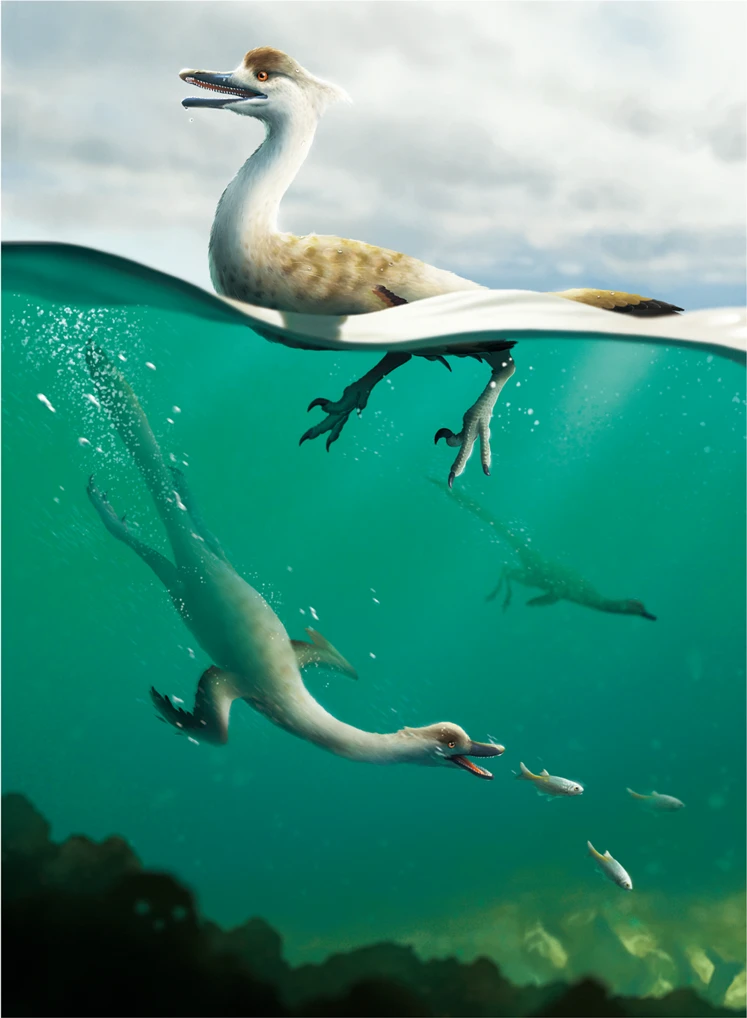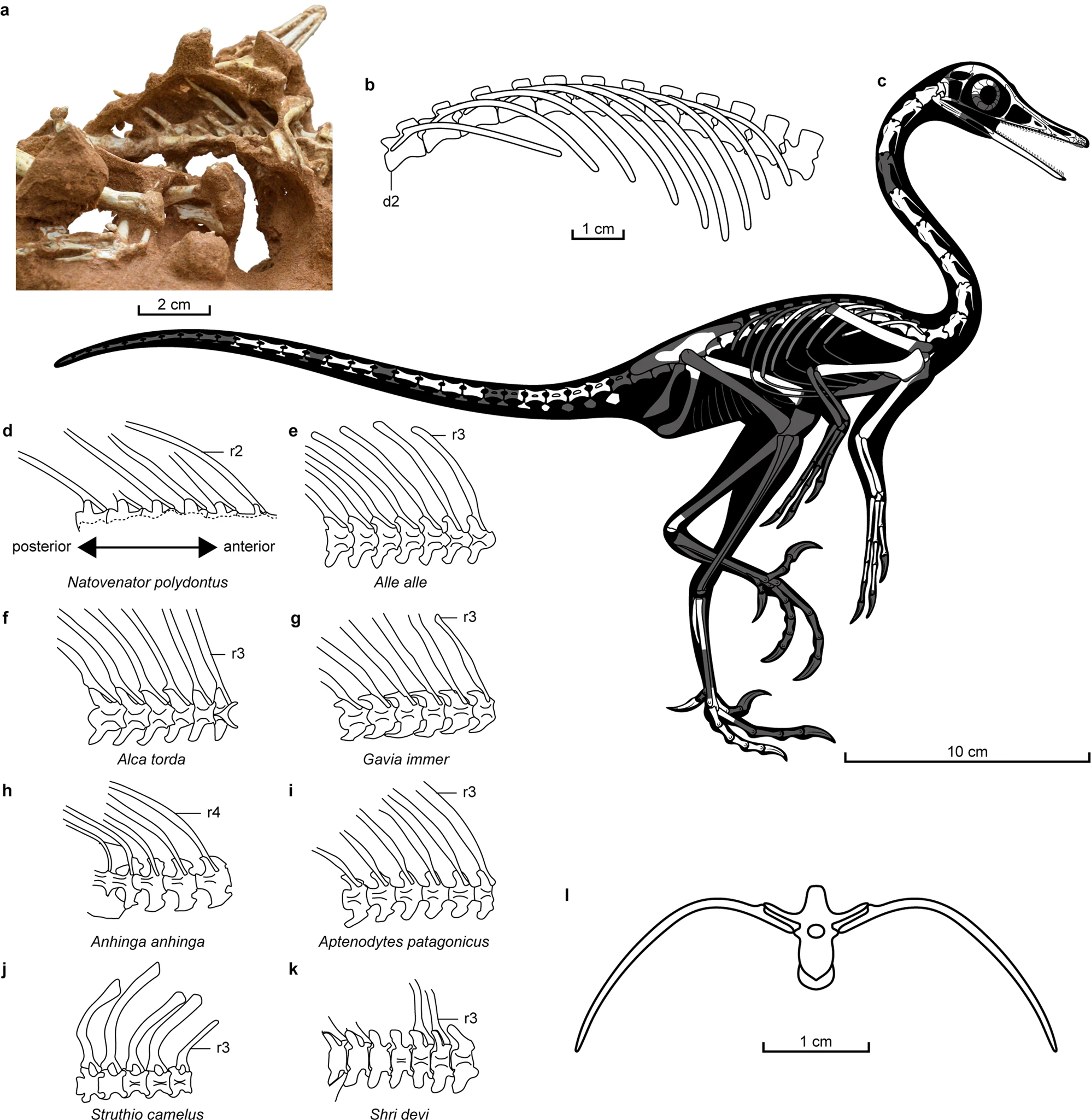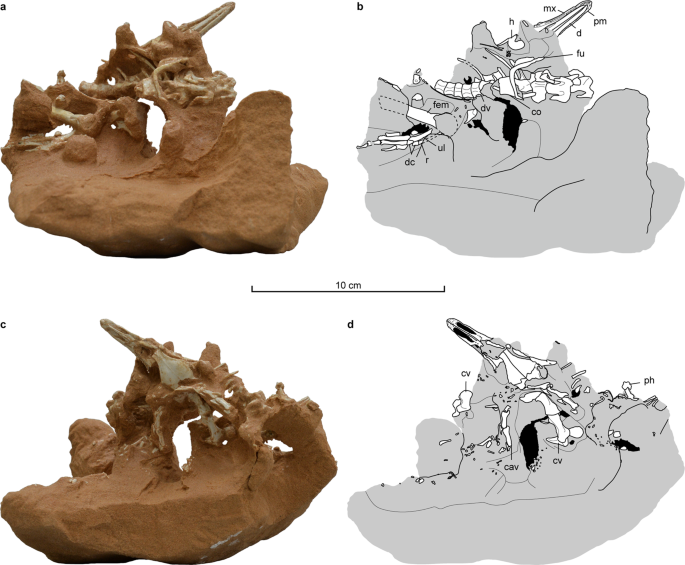
Natovenator likely swam to catch small prey.
For more than 150 million years, amazing dinosaur species in every shape and size filled Earth's habitats. Long-necked giants, living tanks, razor-toothed carnivores and brightly colored birds proliferated through the Mesozoic world. But for all their diversity and success, it seemed dinosaurs were reluctant to take the plunge. Through two centuries of discovery, no non-avian dinosaur was ever found with adaptations best suited to swimming and diving, even as other forms of reptiles made the transition from land to water. But now, at long last, paleontologists have found a swimming dinosaur.
The newly named species, described Thursday in Communications Biology, was not a saurian giant. The small swimmer was only about a foot long and lived in prehistoric Mongolia about 71 million years ago. Despite being a cousin of sharp-toothed predators such as Velociraptor, the new dinosaur had a very different, streamlined look and long jaws fully of tiny teeth. Seoul National University paleontologist Sungjin Lee and colleagues have named the dinosaur Natovenator polydontus, the "many-toothed swimming hunter."
The new dinosaur was found in the Gobi Desert at a place called Hermiin Tsav, famous among paleontologists for preserving multiple dinosaur species and other forms of ancient life. Careful preparation of the dinosaur's bones was required before the strange nature of this new species became apparent. After the bones were exposed, Lee says, "we realized that this was something special, because it was beautifully preserved with a nice skull and an extremely long neck." As the experts looked closer, the fossil seemed to share some traits with another species, Halszkaraptor, that was named in 2017 and initially interpreted as a swimming dinosaur. The hypothesis generated a great deal of debate, however, and so Lee and co-authors scrutinized the bones of Natovenator carefully. In the end, the researchers determined, Natovenator was a swimmer. "We think it looked like a Cretaceous cormorant," Lee notes.
Naturally, paleontologists are many millions of years too late to watch Natovenator in life and observe what a dinosaur stroke might look like. Paleontologists will have to dig in further to ascertain how the dinosaur's anatomy translates to the animal's behavior. "In spite of evidence that is not entirely conclusive, I think that some anatomical details of Natovenator are good indicators that the animal was probably aquatic," says Argentine Natural Science Museum paleontologist Federico Agnolin, who was not involved in the new study.
The long jaws and many tiny teeth of Natovenator could be an adaptation to snatching small, slippery or wriggling prey from the water. More than that, Lee and co-authors note, the preserved ribs of Natovenator are oriented in a swept-back fashion similar to that of penguins and auks. The arrangement appears to be a form of skeletal streamlining that would have allowed Natovenator to swim more efficiently in Cretaceous lakes and streams. Such streamlining has not yet been seen in any other dinosaur species.
Of course, there is existing evidence that some dinosaurs swam now and then. Deep scratches in muddy sediment made by other dinosaurs have been found at various places around the world from time periods millions of years apart. Most of the time these tracks were made by theropod dinosaurs as they crossed rivers or waded out into the shallows in search of a fish dinner. The great sail-baked dinosaur Spinosaurus, too, has been interpreted as being more aquatic than most other species. Debate remains about whether Spinosaurus was a skilled swimmer or even hunted prey while wholly submerged, but the dense bones of the dinosaur and its croc-like jaws hint that the immense predator was at least wading around in the shallows in search of a lungfish or coelacanth to eat. But Natovenator is distinct from these earlier examples, because it appears to have specific adaptations related to moving through the water.
/https%3A%2F%2Ftf-cmsv2-smithsonianmag-media.s3.amazonaws.com%2Ffiler_public%2Fc8%2Fce%2Fc8ced1d4-31f5-4360-ad8b-df138bad3bbe%2Fimage-1-web.jpg)
World’s First Swimming Dinosaur Discovered in Mongolia
Natovenator was a streamlined hunter with jaws full of tiny teeth
Holotype:
MPC-D 102/114 (Institute of Paleontology, Mongolian Academy of Sciences, Ulaanbaatar, Mongolia) is a mostly articulated skeleton with a nearly complete skull.
Locality and horizon:
Baruungoyot Formation (Upper Cretaceous), Hermiin Tsav, Omnogovi Province, Mongolia.
Etymology:
Natovenator, from the Latin nato (swim) and venator (hunter), in reference to the hypothesized swimming behaviour and piscivorous diet of the new taxon; polydontus, from the Greek polys (many) and odous (tooth) in reference to the unusually many teeth.

(a Dorsal series of Natovenator in ventral view. b Reconstruction of dorsal vertebrae and ribs of Natovenator in left lateral view. c Skeletal reconstruction of Natovenator with missing parts in dark grey. d–i Dorsal rib morphology of Natovenator (d), diving birds (e–i), common ostrich (j), and Shri devi, a likely terrestrial dromaeosaurid from the Baruungoyot Formation (k) in ventral view (not to scale). l Reconstruction of the fourth dorsal vertebra with corresponding ribs in anterior view. d2 second dorsal vertebra, r2 second dorsal rib, r3 third dorsal rib, r4 fourth dorsal rib.)

A non-avian dinosaur with a streamlined body exhibits potential adaptations for swimming - Communications Biology
Presenting Natovenator polydontus, a non-avian dinosaur from the Upper Cretaceous of Mongolia displaying morphology indicative of swimming behaviour.









